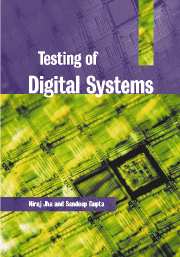Book contents
- Frontmatter
- Contents
- Preface
- List of gate symbols
- 1 Introduction
- 2 Fault models
- 3 Combinational logic and fault simulation
- 4 Test generation for combinational circuits
- 5 Sequential ATPG
- 6 IDDQ testing
- 7 Functional testing
- 8 Delay fault testing
- 9 CMOS testing
- 10 Fault diagnosis
- 11 Design for testability
- 12 Built-in self-test
- 13 Synthesis for testability
- 14 Memory testing
- 15 High-level test synthesis
- 16 System-on-a-chip test synthesis
- Index
4 - Test generation for combinational circuits
Published online by Cambridge University Press: 05 June 2012
- Frontmatter
- Contents
- Preface
- List of gate symbols
- 1 Introduction
- 2 Fault models
- 3 Combinational logic and fault simulation
- 4 Test generation for combinational circuits
- 5 Sequential ATPG
- 6 IDDQ testing
- 7 Functional testing
- 8 Delay fault testing
- 9 CMOS testing
- 10 Fault diagnosis
- 11 Design for testability
- 12 Built-in self-test
- 13 Synthesis for testability
- 14 Memory testing
- 15 High-level test synthesis
- 16 System-on-a-chip test synthesis
- Index
Summary
In this chapter, we discuss automatic test pattern generation (ATPG) for combinational circuits. We begin by introducing preliminary concepts including circuit elements, ways of representing behaviors of their fault-free as well as faulty versions, and various value systems.
Next, we give an informal description of test generation algorithms to introduce some of the test generation terminology. We then describe direct as well as indirect implication techniques.
We discuss a generic structural test generation algorithm and some of its key components. We then describe specific structural test generation paradigms, followed by their comparison and techniques for improvement.
We proceed to some non-structural test generation algorithms. We describe test generation systems that use test generation algorithms in conjunction with other tools to efficiently generate tests.
Finally, we present ATPG techniques that reduce heat dissipated and noise during test application.
Introduction
While most practical circuits are sequential, they often incorporate the full-scan design for testability (DFT) feature (see Chapter 11). The use of full-scan enables tests to be generated using a combinational test generator. The input to the test generator is only the combinational part of the circuit under test (CUT), obtained by removing all the flip-flops and considering all the inputs and outputs of the combinational circuit as primary inputs and outputs, respectively. If the generated tests are applied using the full-scan DFT features and the test application scheme described in Chapter 11, the fault coverage reported by the combinational test generator is achieved.
- Type
- Chapter
- Information
- Testing of Digital Systems , pp. 134 - 265Publisher: Cambridge University PressPrint publication year: 2003

